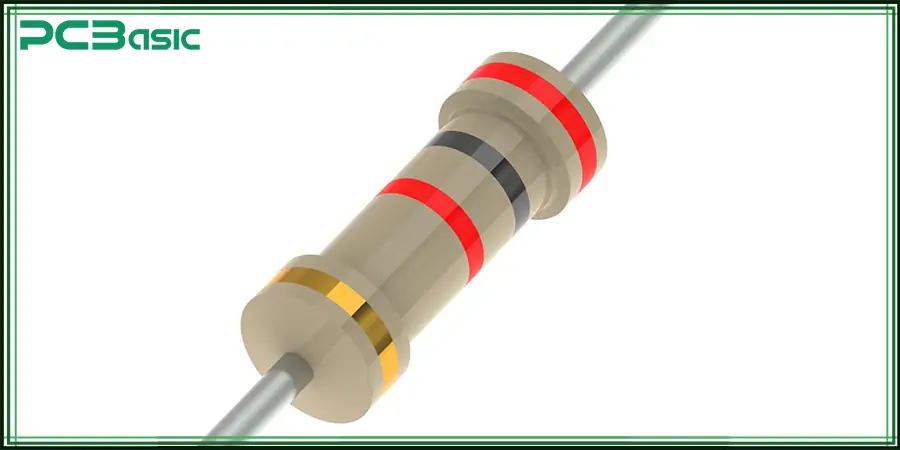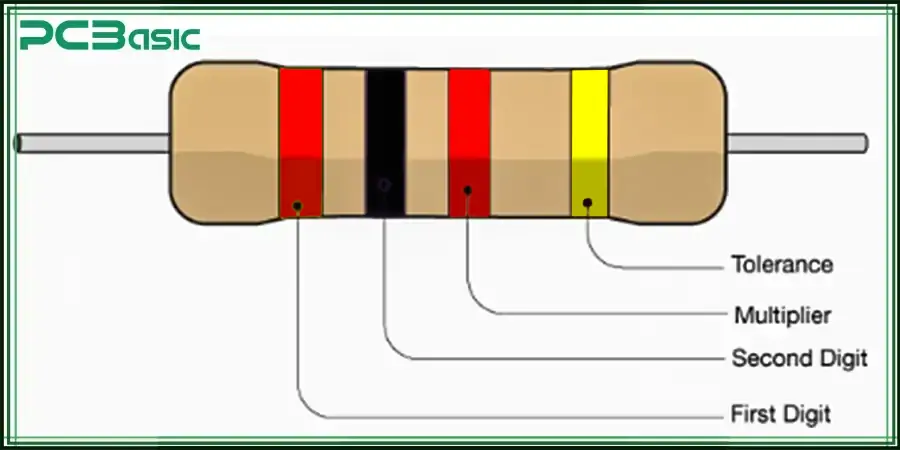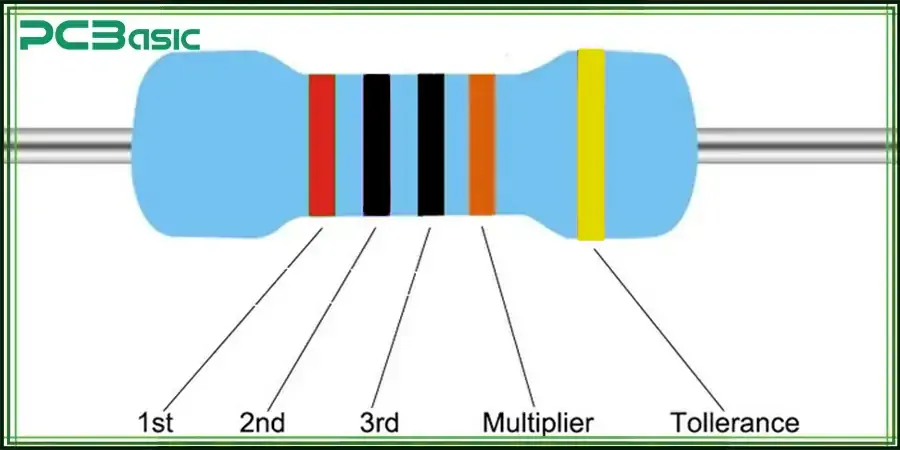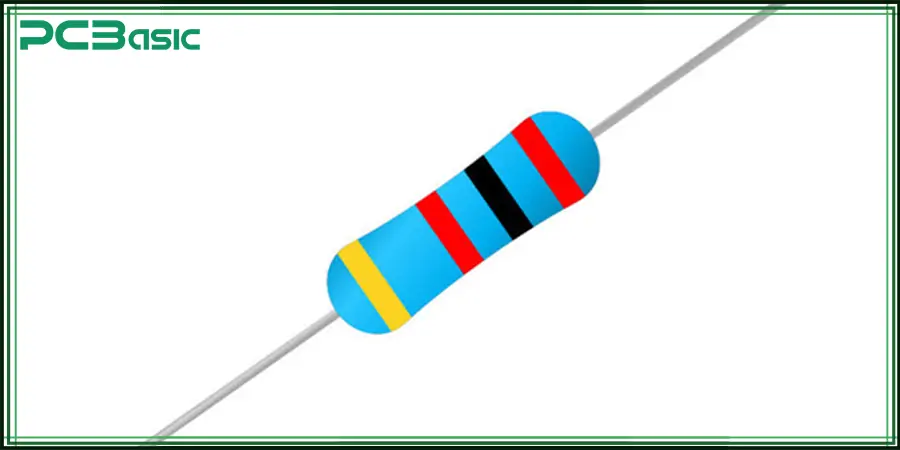Global high-mix volume high-speed PCBA manufacturer
9:00 -18:00, Mon. - Fri. (GMT+8)
9:00 -12:00, Sat. (GMT+8)
(Except Chinese public holidays)
Global high-mix volume high-speed PCBA manufacturer
9:00 -18:00, Mon. - Fri. (GMT+8)
9:00 -12:00, Sat. (GMT+8)
(Except Chinese public holidays)
HomePage > Blog > Knowledge Base > Resistor Color Code Explained - 2K Resistor Color Code
Resistors are one of the basic building blocks of electronic circuits that limit the current flowing through the circuit, dividing voltages, among other applications. The main recognizable feature of resistors is the color codes, which show the resistance values in ohms, tolerance, and sometimes power rating.
We’ll discuss the resistor color code in depth, and specifically focus on the 2K (2000 ohms) resistor color code. We will cover:
· Resistor basics, and why color code is used
· How to read resistor color codes
· 2K resistor color codes
· If 2K is a standard resistor value
· 2K resistor common applications.
By the end of this article, you will be able to spot a 2K resistor by color code and know where they fit into an electrical circuit.

The resistor is a two-terminal electronic component that adds resistance to a circuit element. It is used to control voltages and currents, protect circuit components from being damaged, and divide voltages. The various types of resistors are:
· Fixed resistors (e.g., carbon film, metal film, wire-wound) and the like
· Variable Resistors (Potentiometers, Rheostats)
· Special resistors (such as thermistors, varistors)
Resistors are color coded as a low-cost, convenient method of indicating resistance value, tolerance, and, in some cases, other features such as temperature coefficient and reliability rating. The main reason is the physical size of resistors; resistors are typically small, cylindrical components with limited flat area. And since it's neither easy nor space-efficient to print numeric values directly on them, at least in small circuits. In contrast, colored bands offer a legible, long-lasting, and universal way that anybody trained in electronics can quickly read.
Each band of color on a resistor is related to a number or multiplier, which can be looked up on a chart, to help figure out the resistance of that resistor. As well as being space-saving, it also provides wear resistance and anti-heat properties, and is resistant to humidity. In some cases, manufacturers will fail to include a few bands if they’re not really important to the intended usage/description of the resistor, like maybe tight tolerance or something about how reliable the resistor is.

Advantages of the Resistor Color Code:
· Small marking: Fits on little parts
· Fast identification: Makes technicians and engineers read values easily and quickly
· Standardization: To have a uniform convention of resistor marking all around the world
Industry Standards and EIA Value Series:
Resistors are produced in reference value series as defined by the Electronic Industries Alliance (EIA):
· Discs are also found in E6, E12, E24, and E96 values, according to the tolerance.
Resistors are marked with colored bands which tell you their resistance value, in ohms, and their tolerance (how much their actual resistance can deviate from the labelled value).
|
Color |
Digit |
Multiplier |
Tolerance |
|
Black |
0 |
×1 |
|
|
Brown |
1 |
×10 |
±1% |
|
Red |
2 |
×100 |
±2% |
|
Orange |
3 |
×1,000 |
|
|
Yellow |
4 |
×10,000 |
|
|
Green |
5 |
×100,000 |
±0.5% |
|
Blue |
6 |
×1,000,000 |
±0.25% |
|
Violet |
7 |
×10,000,000 |
±0.1% |
|
Gray |
8 |
×100,000,000 |
±0.05% |
|
White |
9 |
|
|
|
Gold |
|
×0.1 |
±5% |
|
Silver |
|
×0.01 |
±10% |
|
None |
|
|
±20% |
4-band color coding is the most common technique used in general-purpose resistors. Those resistors normally have the tolerance ±5% or ±10%. The band sequence and color of 4-band resistors are:
· The first ring is the first digit of the resistance value.
· The next band is the next most important digit.
· The third one is an order of magnitude multiplier, which says how many 0s to append, or whatever, to the first two digits.
· The fourth ring indicates tolerance (how precisely the resistor was made).
For example, take the 2K ohm resistor:

· Band 1: Red = 2
· Band 2: Black = 0
· Band 3: Red = ×100
· Band 4: as above - Gold = ±5% (or Silver = ±10%)
5-band resistors are usually selected when a higher degree of accuracy is needed. These are primarily used in applications or circuits requiring closer tolerances, such as ±1% or less. The 5-band version extends the 4-band to include a 3rd significant digit, allowing a more specific value for resistance.
· Band 1 is the first significant figure.
· The second band represents the 2nd digit.
· The third band represents the third significant digit.
· The level multiplier is the fourth band.
· The fifth band is tolerance.
For a 2K ohm resistance in 5-band it looks like:

· Band 1: Red = 2
· Band 2: Black = 0
· Band 3: Black = 0
· Band 4: Brown = ×10
· Band 5: Gold = ±5%

A 2K device measures 2 kilo-ohms (2000 ohms). It is also offered for voltage divider, pull-up/pull-down, and signal conditioning applications.
Below is a detailed breakdown of how to read the color code for a 2K resistor in both 4-band and 5-band formats:
2K Resistor Colour Code (4 Band)
The color order for a 4-band 2K Ohm resistor is:
For a 4-band 2K resistor, the color sequence is:
|
Band 1 |
Band 2 |
Band 3 |
Band 4 |
|
Red (2) |
Black (0) |
Red (×100) |
Gold (±5%) |
Calculation:
o Digits: 2 (Red) 0 (Black) → 20
o Multiplier: ×100 (Red) → 20 × 100 = 2000Ω (2KΩ)
o Tolerance: Gold (±5%) → Actual range: 1900Ω to 2100Ω
2K Resistor Color Code (5 Band)
The color code sequence for a 5-band 2K resistor:
|
Band 1 |
Band 2 |
Band 3 |
Band 4 |
Band 5 |
|
Red (2) |
Black (0) |
Black (0) |
Brown (×10) |
Brown (±1%) |
Calculation:
· Digits: 2 (Red) 0 (Black) 0 (Black) → 200
· Multiplier: ×10 (Brown) → 200 × 10 = 2000Ω (2KΩ)
· Tolerance: Brown (±1%) → Actual range: 1980Ω to 2020Ω
When working with electronics, it's common to use resistor values like 100Ω, 470Ω, 1KΩ, or 10KΩ all the time. But what about 2K ohms? Is it a common value that can easily be manufactured? The short answer is yes - 2KΩ is what’s referred to as a “standard resistor value”. To explain the why and the how, we'll have to look closer into the realm of the preferred resistor values and a particular subgroup of them, known around the world as the E-series.
· E6, E12, E24, and E96 series overview
The E series is a system of preferred numbers (a kind of standardization) for nominal sizes of electronic components as defined in IEC 60063. A list of resistor values for each decade (a decade is a factor of ten range, so 10Ω to 100Ω or 1KΩ to 10KΩ) is defined for each E-series. The values are logarithmic, so that each value can be multiplied by a given (fixed, specified) factor until the full span of the decade is covered evenly with the desired tolerance.
The most frequently employed E-series are:
· E6 Series: It is 6 values per decade and for resistors with ±20% tolerance.
· E12 Series: It has 12 different values per decade and can achieve ± 10% tolerance.
· E24 Series: 24 values are available per decade and are suitable for a ±5% tolerance.
· E96 Series: 96 values per decade, applicable to high precision resistors with ±1% tolerance.
Where 2K fits into the series
The 2K (2000 Ohm) component is critical to standardization. As a member of the E24 series, it represents the resistance available with 5% tolerance, making it ideal for general purpose application.
For tighter tolerance requirements, manufacturers offer more accurate values in the E96 family with devices like 2.00K, 2.05K, and 2.10K with a 1% tolerance. This hierarchical standard of values makes it easy for designers to get on with their work: from simple E6 (20 % series) to high-precision E96 (1 % series) – always the right value for them to meet the application requirements as closely as possible, with a view to costs and availability.
The popular application of the 2K resistor within multiple tolerances discloses its inherent significance in electronics. Its flexibility makes it equally valuable in simple educational and industrial-scale applications. From voltage dividers to precision analog circuits, there's practically nowhere in electronic design that the 2K resistor hasn't found an important role, and it continues to be a trusted and effective solution even over 100 years after its invention.
2K Ohm resistors are common types of resistors that are used in many electrical and electronic applications to provide a medium resistance value. Several applications of the above are:
· Voltage Dividers: Ideal for scaling down input voltages for sensors, ADCs, or microcontroller inputs.
· Pull-Up/Pull-Down Resistors: Required for Digital Circuits (I2C Communication, GPIO Pins) to maintain the logic level stable and prevent floating inputs.
· Current Limiting: Operates LEDs and transistors to limit current in bias networks.
· Signal Conditioning: Used to mold signals in op-amp circuits, filters, and impedance-matching networks.
· Timing Circuits: Interacts with capacitors in RC networks to control transient states and timing/oscillating durations.
· Feedback Networks: Used in amplifier circuits to reduce gain and stabilize frequency response.
These uses of the 2K resistor make it a basic element in analogue and digital electronics.
Learning how to read a 2K resistor color code is a basic skill, and vital for anyone working in electronics. Whether you’re using a 4 or 5-band resistor for general applications or high-precision, being able to quickly and accurately identify resistance values is incredibly useful. The calculation in both formats yields the same result and gives the resistance as 2000 ohms, or 2KΩ.
2KΩ is a standard resistor value included in the E24 and E96 series, but not in the E12 series. With tolerances from ±10 percent to ±1 percent, 2K resistors are found in hobby projects to precision instruments. Regardless of whether you are building a new circuit or testing an existing one, knowing the value of the resistors you are working with is extremely important if you are to complete the task at hand.
 About PCBasic
About PCBasic
Time is money in your projects – and PCBasic gets it. PCBasic is a PCB assembly company that delivers fast, flawless results every time. Our comprehensive PCB assembly services include expert engineering support at every step, ensuring top quality in every board. As a leading PCB assembly manufacturer, we provide a one-stop solution that streamlines your supply chain. Partner with our advanced PCB prototype factory for quick turnarounds and superior results you can trust.

Assembly Enquiry
Instant Quote
Phone contact

+86-755-27218592
In addition, we've prepared a Help Center. We recommend checking it before reaching out, as your question and its answer may already be clearly explained there.
Wechat Support

In addition, we've prepared a Help Center. We recommend checking it before reaching out, as your question and its answer may already be clearly explained there.
WhatsApp Support

In addition, we've prepared a Help Center. We recommend checking it before reaching out, as your question and its answer may already be clearly explained there.
